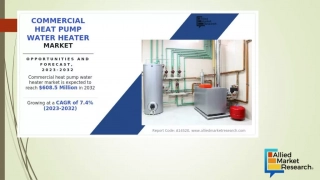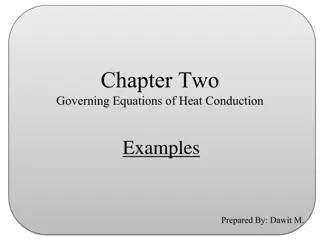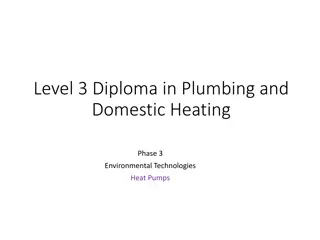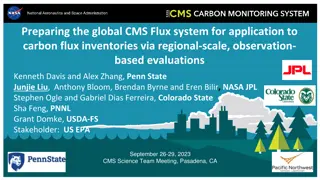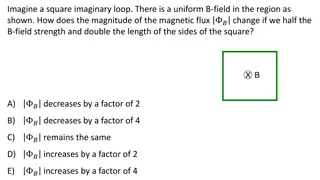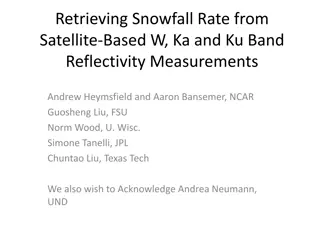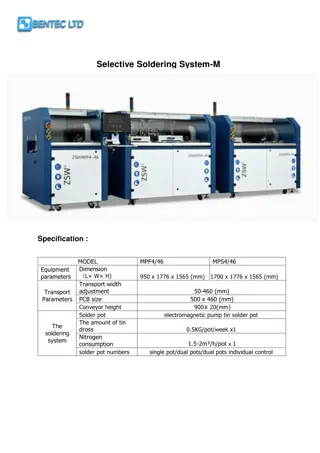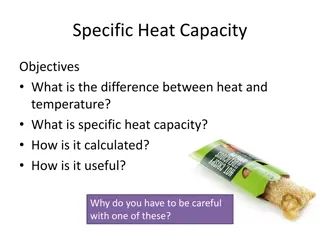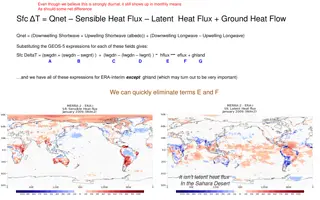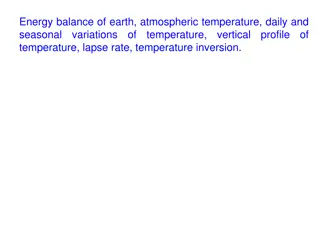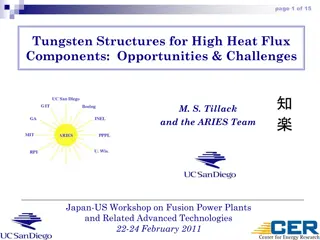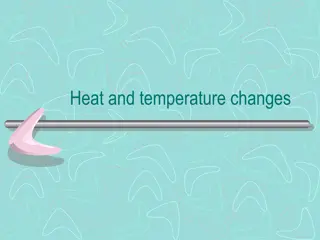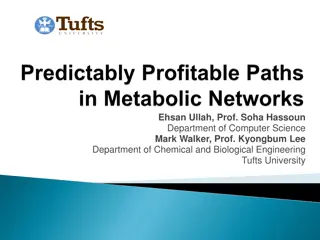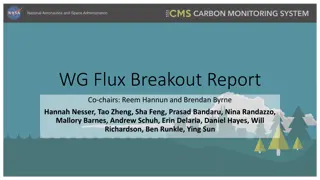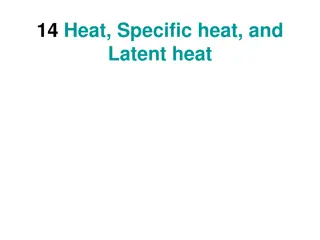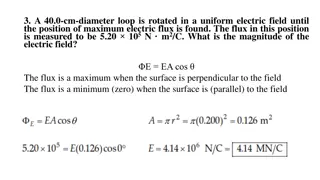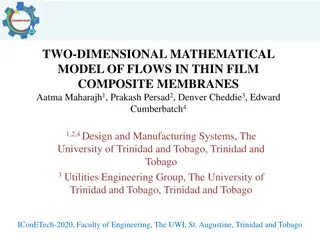commercial heat pump water heater market
Heat pump water heaters are used to move heat from the source to a sink, by utilizing electricity instead of generating heat directly. Heat pumps are used to facilitate the movement of thermal energy by absorbing heat from a cold space and release it. Further, several commercial businesses such as h
2 views • 6 slides
Applications of Heat Exchangers in Various Industries
This topic delves into the diverse applications of heat exchangers in different industries and plants, elucidating the use of various types of heat exchange systems and their importance in processes like bio-processing, power generation, and more. The lecture covers heat exchange applications for li
0 views • 24 slides
Understanding AGN Jet Production Efficiency: Insights from Spin and Magnetic Flux
A fundamental question in astrophysics is how efficiently active galactic nuclei (AGN) produce jets. Black hole spin and magnetic flux play crucial roles in determining the jet production efficiency. High-spin values and large magnetic flux threading are essential for generating high-efficiency jets
2 views • 22 slides
Energy and Heat Transfer Problems Explained
Solve various physics problems related to heat transfer, specific heat, latent heat, and efficiency in heating devices. Calculate the amount of heat needed to raise the temperature of different substances, melt solids, and evaporate water. Explore concepts like specific heat, latent heat of fusion,
2 views • 25 slides
Improving Heat Rate Efficiency at Illinois Coal-Fired Power Plants
Heat rate improvements at coal-fired power plants in Illinois are crucial for enhancing energy conversion efficiency, reducing carbon intensity, and minimizing pollution. By increasing the heat rate/efficiency by 6%, these plants can generate more electricity while burning the same amount of coal. T
2 views • 11 slides
Chapter Two Governing Equations of Heat Conduction
This compilation covers examples and governing equations of heat conduction, including boundary conditions and scenarios involving one-dimensional conduction in various structures. It explores scenarios like steady-state conditions in a plane wall, heat conduction along a pipeline, and temperature d
0 views • 12 slides
Insights on Outdoor Heat Exposure: OSHA Data Collection Pilot 2022
The Occupational Safety and Health Administration (OSHA) conducted a Data Collection Pilot from June to September 2022 to quantify outdoor heat exposure and assess employer heat illness prevention programs. Key findings include identifying elements of successful prevention programs, comparing workpl
0 views • 22 slides
Review of Critical Heat Flux in Liquid Hydrogen, Methane, and Oxygen
This review paper presents data and predictive tools on the critical heat flux (CHF) of liquid hydrogen, methane, and oxygen. It covers the motivation for CHF modeling, background on pool and flow boiling curves, availability of CHF data for different liquids, and applications in space propulsion sy
0 views • 15 slides
Heat Injury Prevention and Hydration Tips for Safety at Work
Discussing the importance of heat injury prevention, this content provides valuable guidelines on recognizing heat-related issues, staying hydrated, and maintaining a safe environment in challenging weather conditions. Tips include monitoring the heat index, using heat stress thermometers, providing
1 views • 7 slides
Occupational Heat Exposure Control and Prevention Practices
Occupational Heat Exposure Control and Prevention Practices at the New Mexico Institute of Mining and Technology covers training for workers exposed to excessive heat, pre-test evaluation, objectives focusing on heat stress and exposure, understanding heat and heat stress, human body's response to h
1 views • 37 slides
Understanding Heat, Temperature, and Energy Transfer
Delve into the concepts of heat and temperature, exploring their relationship and implications in energy transfer. Discover the significance of heat capacity, specific heat capacity, and how mass influences the heating and cooling rate of substances. Learn how to calculate heat using specific heat c
3 views • 12 slides
Understanding Heat and Temperature in Thermodynamics
Thermal energy transfer, heat, and temperature play crucial roles in determining the behavior of systems in terms of kinetic energy and molecular motion. The zeroth law of thermodynamics establishes the relationship between heat and temperature. Heat transfer leads to changes in the average kinetic
8 views • 8 slides
Extreme Heat Preparedness and Impacts: CERT Hazard Annexes
Introduction to CERT Hazard Annexes focusing on extreme heat, discussing heat-related illnesses, impacts of extreme heat, and preparedness measures including insulation, window protection, and attic fans. The content emphasizes the preventable nature of heat-related illnesses and the vulnerabilities
0 views • 26 slides
Understanding Heat Pumps and Their Efficiency
Heat pumps are essential in modern environmental technologies, transferring heat from one area to another efficiently. They work on a refrigeration cycle principle, converting low-temperature heat to higher temperatures. The heat pump system's efficiency is measured by the Coefficient of Performance
0 views • 124 slides
Understanding Heat Transfer in Science
Investigate and understand the movement of heat between objects through conduction, convection, and radiation. Learn to compare materials that conduct heat with insulating materials, describe heat transfer processes, and design experiments to study heat energy movement. Explore the use of ratio reas
0 views • 31 slides
Application of CMS-Flux System for Carbon Flux Inventories Evaluation
Preparation for the global CMS Flux system integration with US forest and agricultural carbon inventory data to quantify uncertainties and enhance inventory-relevant flux estimates. The project aims to evaluate the utility of CMS-Flux-NA system for top-down assessment of US agricultural and forest C
2 views • 21 slides
Understanding Magnetic Flux and Induced Current in Loops
Explore concepts related to magnetic flux and induced current in loops through visual scenarios involving uniform magnetic fields, loop movements, and changes in magnetic flux. Test your understanding with multiple-choice questions on induced EMF, loop bending, and maximizing magnetic flux. Enhance
1 views • 54 slides
Retrieving Snowfall Rate from Satellite-Based W, Ka, and Ku Band Reflectivity Measurements
This study discusses methods for retrieving snowfall rate from satellite-based reflectivity measurements, specifically focusing on developing S-Z relationships through collocations and conservation of mass flux. It highlights the importance of identifying differences between retrieval products and t
0 views • 13 slides
Understanding Heat Transfer Mechanisms
Heat transfer is a fundamental concept in physics, involving the movement of thermal energy between objects. This interactive content explores different types of heat transfer such as conduction, convection, and radiation. It discusses how heat is measured, the properties of various materials in con
0 views • 4 slides
Advanced Selective Soldering System with Flux Spray and Preheating Modules
The Selective Soldering System-M offers precise soldering capabilities with features like individual pot control, flux spray module for reduced contamination, and preheating module for lead-free and multi-layer boards. It minimizes flux consumption and ionic contamination while ensuring high positio
0 views • 6 slides
Understanding Enthalpy and Heat Capacity in Chemistry
Enthalpy is a measure of total energy in a system, represented as H = E + P.V. Heat at constant pressure relates to enthalpy changes. Calorimetry and heat capacity help measure and understand heat in chemical reactions. Specific heat capacity and molar heat capacity play key roles in determining ene
0 views • 16 slides
Understanding Heat-Related Illnesses in Sports Medicine
Hyperthermia is a condition where body temperature is elevated, posing risks like heat stress and heat-related illnesses. Proper knowledge of factors like temperature, humidity, and hydration is crucial for athletes and coaches to prevent such conditions during workouts. Metabolic heat production, c
1 views • 29 slides
Understanding Specific Heat Capacity and its Importance in Heat Transfer
Discover the key differences between heat and temperature, grasp the concept of specific heat capacity, how it is calculated, and its practical applications in energy transfer processes. Be cautious with hot objects like an apple pie to avoid burns. Explore how specific heat capacity influences the
0 views • 17 slides
Understanding Cumulus Parameterization and Mass-Flux Schemes in Atmospheric Science
Explore the significance of mass-flux schemes in cumulus parameterization, their interaction with grid-scale microphysics, and the key elements and assumptions involved. Learn about the objectives, components, and limitations of classical cumulus schemes for atmospheric modeling. Gain insights into
0 views • 23 slides
Understanding Heat Stress and Prevention Techniques
Heat stress can lead to various heat-related illnesses and affect concentration at work. It's essential to be hydrated, wear appropriate gear, and monitor symptoms to prevent heat-related issues. Factors like hydration levels, environmental conditions, and personal health play a crucial role in mana
0 views • 11 slides
Biomass-Flux Working Group Overview
The Biomass-Flux Working Group, a collaboration involving various organizations like NASA and universities, aims to integrate land-atmosphere carbon fluxes and biomass changes to enhance estimations and understanding. By identifying overlapping projects, encouraging cross-comparisons, and reconcilin
0 views • 10 slides
Understanding Magnetic Flux and Induction Principles
Exploring the concepts of magnetic flux and electromagnetic induction through visual aids and explanations. Topics include the generation of current in coils, Faraday's law, Lentz's law, and the behavior of induced current with changing flux.
0 views • 36 slides
Introduction to State Management with Flux and Redux in JavaScript Apps
Explore the concepts of Flux and Redux for efficient state management in JavaScript applications, understanding their architecture, key components, and benefits in simplifying data flow. Dive into the unidirectional data flow pattern of Flux and the inspired improvements in Redux, alongside the comp
0 views • 13 slides
Analysis of Surface Temperature and Heat Flux Relationships
Exploring the interplay between surface temperature, sensible heat flux, latent heat flux, and ground heat flow, utilizing data from GEOS-5 and ERA-interim models to understand the impact of different heat flux components on surface temperature variations in diurnal cycles and monthly means. Compari
0 views • 8 slides
Understanding Sterilization Methods and Equipment for Pharmaceutical Products
Sterilization is crucial in the production of sterile pharmaceuticals, involving the removal or destruction of microorganisms to ensure product safety. Methods include physical (moist heat, dry heat, irradiation), chemical (gaseous, liquid sterilants), and non-thermal techniques like ethylene oxide
0 views • 35 slides
Understanding Earth's Energy Balance and Temperature Variations
Earth's energy balance is crucial for maintaining atmospheric temperature and regulating daily and seasonal temperature changes. The net radiation, consisting of incoming shortwave and outgoing longwave radiation, plays a key role in this balance. Components such as sensible heat flux, latent heat o
0 views • 18 slides
Satellite Applications in Estimating Earth's Surface Energy Budget
Satellites play a crucial role in estimating the Surface Energy Budget (SEB) by providing data on various components such as Surface Radiation Budget and Surface Turbulent Fluxes. The SEB includes factors like net radiation flux, sensible and latent heat fluxes, and subsurface heat transfer. Satelli
0 views • 38 slides
Tungsten Structures for High Heat Flux Components: Opportunities & Challenges
Tungsten has a long history in fusion research, with applications in high-heat-flux components. He-cooled W structures offer performance advantages, such as high heat flux capability and good safety characteristics. Various design configurations and cooling schemes have been developed, with a focus
0 views • 15 slides
Understanding Heat Exchangers in Food Operations and Equipment
Explore the world of heat exchangers used in food operations, including pasteurization, blanching, evaporation, drying, sterilization, freezing, and extrusion. Learn about different types of heat exchange equipment such as double tube heat exchangers, shell and tube heat exchangers, and plate heat e
0 views • 40 slides
Understanding Heat and Temperature Changes in Chemistry
Heat and temperature changes in chemistry are crucial concepts to comprehend. Heat capacity, molar heat capacity, and specific heat capacity play significant roles in determining temperature changes when heat energy is added or removed. Different substances have varying abilities to absorb heat, aff
0 views • 17 slides
Pathway Analysis in Systems Biology
This article delves into the realm of pathway analysis in systems biology, focusing on methods such as embedding new pathways, enumeration of elementary flux modes, flux variations in metabolic networks, and identification of profitable networks. It explores strategies for optimizing metabolic pathw
0 views • 20 slides
Flux Working Group Report and Synthesis Activities
The Flux Working Group, led by Co-chairs Reem Hannun and Brendan Byrne, focuses on quantifying carbon balance from point sources to global domains. Their goal is to provide data for understanding processes at various scales, developing models, and informing policy decisions. The group engages in var
0 views • 6 slides
Understanding Heat, Specific Heat, and Latent Heat
Heat is energy transferred between objects due to temperature difference. Specific heat capacity measures the amount of heat needed to change the temperature of a substance. Latent heat is the energy required for a phase change without a temperature change. Calorimetry and measuring specific heat ar
0 views • 14 slides
Electric Field and Flux Calculations in Different Geometries
Explore various scenarios involving electric fields and flux calculations, such as finding the magnitude of electric fields in different situations, determining electric flux through surfaces, assessing net electric flux through charges in a submarine, and analyzing flux through faces of geometric s
0 views • 13 slides
Two-Dimensional Mathematical Model of Flows in Thin Film Composite Membranes
This study presents a mathematical model for flows in thin film composite membranes, focusing on the permeation of solvent flux and solute rejection. Assumptions include incompressible fluid, constant diffusion of chemical species, and isothermal conditions. Equations describe water flux, solute flu
0 views • 19 slides
